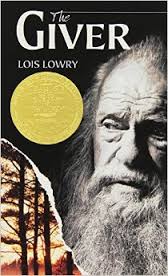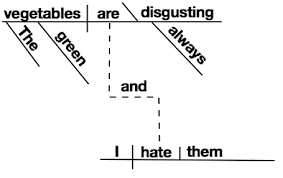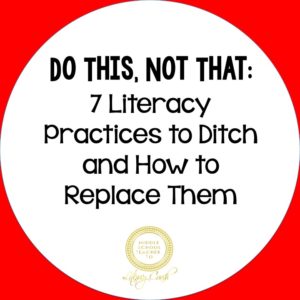We’ve all done it, reflected back on something we used to do while teaching that we would never do again. When I look back at some of the teaching practices I’ve used, it literally makes me cringe. Does it mean we were bad teachers? No. I’m a believer that teachers always do the best they can do for their students with the resources and knowledge they have at the time. Isn’t it a beautiful thing that we live in a world where we can continuously learn, gain new knowledge, and make changes to improve ourselves? That’s what this blog post it all about. How can you ditch some commonly-used literacy practices that can be replaced with practices that will serve you and your students better?
#1: Whole Class Novels
Why we should ditch it: When all students are reading the same book, at the same pace, with the same purpose, troubles are sure to arise. What about your advanced student who could read the entire book in one night’s sitting (and probably will)? That student will spend the next several weeks in sheer boredom, recalling what he or she read on that fateful evening where they finished the class novel, in one night… On the other end, what about your lowest readers who are not capable of reading the book by themselves? They will be forever behind, unable to participate in the reading discussion and/or answer the book questions. Another interesting thing happens when teachers teach whole-class novels. They let the novel become the center of teaching and lose sight of the only point of a whole class novel: teaching reading. It’s easy to worry more about if students understand what’s going on in one book than if students are using reading behaviors to process their reading.
What to replace it with: Replace whole class novels with a combination of interactive read aloud, guided reading, literature circles, and independent reading. The interactive read aloud will give you that whole-class book experience and a common reference point for modeling reading behaviors and thinking during Reading Workshop minilessons. Guided reading and literature circles will provide small group reading instruction differentiated to students’ reading levels and reading preferences. Ditching whole-class novels will also free up time for independent reading, where students can spend time with books they love and want to read. For more information about using these Reading Workshop practices in combination, check out this blog post.
#2: Isolated Grammar Exercises
Why we should ditch it: The only logical reason to teach students about grammar is so that they can use it correctly in their writing. That’s it. I teach my students grammar so that they can improve their writing conventions so that their writing is understandable, clear, and grammatically correct. I used to teach grammar using predictable, scripted sentences. Doing grammar exercises with my students felt like doing math. And you know what? It felt great! There was a right answer, a wrong answer, a predictable pattern, and all those other things black-and-white-thinking people love. But then this thing happened, and my students would do a piece of writing, and that isolated, predictable grammar rule didn’t play nice in real-person writing. It wasn’t recognizable in the books my students read. It was pretty much pointless. I had created grammar exercise experts who couldn’t write a grammatically-correct sentence.
What to replace it with: When working with students on grammar, I prefer not to refer to it as grammar at all. Instead, I teach from the perspective of learning how to write using correct writing conventions. This already gets students’ brains to make the connection that the sole purpose for learning about grammar is so that we can transfer our learning to writing. The next difference is to use mentor sentences from novels and students’ writing. Messy sentences that aren’t always completely clear, but they teach students that writing is messy, and writers are problem-solvers, not rule-followers. Mentor sentences can be used to name and practice grammar rules. They can also be used to have students mimic mentor sentences in their writing. Another practice I love is to teach students a grammar rule and have them look through their writing or independent reading book for a sentence that exemplifies this rule. For more on mentor sentences, check out this blog post.
#3: Teaching “Books”
Why we should ditch it: When someone asks you what type of teacher you are, you don’t say, “I’m a book teacher.” Chances are, you refer to yourself as a Reading Teacher. However, if I would have been speaking accurately early on in my teaching career, I would have defined myself as a “Book Teacher.” A book teacher gives out worksheets on every chapter with questions like, “What happened to Jonas on page 5 when….” These worksheets are followed up by chapter quizzes with similar questions. Teachers who teach books are more concerned that students know what’s going on in a book than what type of thinking students are doing while reading the book. The problem with being a “Book Teacher” is students end up learning more about (you guessed it) the book over learning about reading skills. We are not preparing our students to be able to answer every trivia question about Huckleberry Finn, we’re teaching them how readers think while reading any book.
What to replace it with: Reading teachers teach reading behaviors and ask students to apply that thinking to books. Reading minilessons taught should center around the strategic reading actions: solving words, summarizing, reading fluently, predicting, inferring, making connections, synthesizing, analyzing, and critiquing. My favorite place to go when creating reading minilessons is Fountas and Pinnell’s The Continuum of Literacy Learning. An example of a reading minilesson focused on one specific reading behavior that students could apply to their independent reading book is, “Readers consider characters’ decisions so that they can infer why characters made the decisions they did.” The guided reading tab breaks down the different strategic actions into individual reading skills. Good reading teachers also make sure that their questioning during interactive read aloud and guided reading covers within, beyond, and about the text questions as well.
#4: Assigning Writing
Why we should ditch it: Assigning writing means that we tell students what we want them to write and then ask them to do it. It happens all the time. Teachers tell students, “I want you to write a three paragraph reaction to what just happened in the book.” For many students, this is highly stressful and unattainable. Even for many adults, the thought of being asked to write pretty much anything can bring a high level of anxiety. So as adults, what do we do when we’re asked to write a cover letter for a job we’re applying for? We go on the Internet, and we find examples of successful cover letters and read tips about what to include in a cover letter. We find resources to show us a model and give us tips for writing pretty much anything we’re asked to write as adults. So why do we expect students to write “cold” at the snap of our fingers once we ask them to write something? Assigning writing is easy initially, but teachers who assign writing versus teaching writing probably notice the following from their student writers: an unwillingness to get started, refusal to do the writing assignment at all, a final product that does not fit the writing that was assigned, and/or a piece of writing with minimal effort.
What to replace it with: Like adult writers, students need a writing target. Mentor texts are perfect for providing students with a model of what the final writing destination looks like. For even the shortest, simplest writing assignments, I use mentor texts. Most of the time, the mentor texts are my writing. Providing this target sets expectations high, makes them clear, and helps students with the hardest part of writing: getting started. Doing my own writing assignments also allows me to give students insights while teacher and monitor if the writing assignment is even worthy of giving in the first place. Taking writing assignments and breaking them down step-by-step is another great strategy to teaching a short or long writing assignment. Sometimes the task of a piece of writing can be completely overwhelming, but like anything, if students are taken through it one step at a time, they are much more likely to feel successful. More tips for teaching writing can be found here.
#5: Round Robin Reading, Popcorn Reading, Etc.
Why we should ditch it: Round robin, popcorn reading, or any other related reading practice means students are taking turns reading the same text out loud while other students reading the same text are following along. One problem with this practice is students have to sit and listen to students who have different fluency levels than them. This interrupts the reading flow and fluency for each individual student. Many students also struggle with comprehension during round robin reading because they’re experiencing anxiety over the thought of reading out loud and the reading is so disconjointed that they can’t concentrate on the meaning. Another problem is that in order for students to grow as readers, they need to process texts independently. If a coach wanted their basketball team to improve, he or she would have all of his/her players work on dribbling, shooting, passing, defense, and endurance. The coach wouldn’t run the practice with everyone sitting on the bench and then ask one player at a time to go out on the court to do a drill while everyone else sat and watched her. This is just silly. So is popcorn reading for this very same reason.
What to replace it with: There are many great alternatives to popcorn reading. What you choose to have your students do and when is going to depend entirely on the purpose for their reading and the type of instructional context you’re using. One alternative to round robin reading includes having students read independently so that they’re able to process the text, work on their fluency, and problem-solve as they read. Another alternative is a teacher read aloud where students listen to the teacher read the text out loud and hear a model of fluent, properly-phrased reading while working on their listening comprehension. In small group reading contexts, a great alternative to popcorn reading includes partner reading with PALS principles where students take turns being the “coach” and “reader.” The coach listens and follows along with the reading and tells the reader to stop when a reading mistake is made and reread. Students can take turns being the coach and the reader, and this can be a great practice used for a portion of reading with the rest of reading done independently. Using fluency drills is another great way to intentionally have students work on what teachers want students to do through popcorn reading: reading out loud. An example of one of the fluency drills I use in small group reading instruction or intervention is selecting a paragraph and doing an Echo Read. I read a sentence and students in the group echo that sentence using the same expression, pausing, intonation, and pronunciations that I used. We repeat this process until we make our way through the paragraph. Next, I have students turn to a partner and take turns reading that same paragraph out loud to one another. I truly believe teachers who use round robin reading want their students to have better fluency, but a targeted fluency drill in a small group setting like this will do so much more than round robin reading will ever do to improve the reading fluency of your students.
#6: Using Lexiles to Limit Reading Choices for Students
Why we should ditch it: A lexile is a scientific measure of where students are at as readers at one point in time. The lexile level of a book is also determined scientifically. As we know as readers, the complexity of a book goes beyond how hard the words in a book are and the length of its sentences. Yes, these things are a piece, but book complexity is also about the themes of a book, the point of view, the plot structure, the literacy devices used, and the background knowledge needed to understand the content. That’s why sending students down to the library with a lexile number written on a piece of paper and instructing them to select a book based on if their lexile level matches the lexile of a book they want to read just doesn’t match up. Students with high lexiles end up with minimal choices of books that are “challenging” enough for them, and students with low lexiles longingly stare at the book they wish they could read as we slowly kill their love of reading and self-confidence as a reader. I don’t know about you, but I don’t walk into Barnes & Noble and select books I want to buy based on my lexile score. Why would we do this to our students?
What to replace it with: We must teach students how to begin reading a book and monitor if it’s a book that they’re able to comprehend. Is the book too hard, too easy, or just right? Teach them how to be Goldilocks in the world of books. What do readers do if a book is too hard or too easy? These are other conversations and lessons we must work with students on. Interest and background knowledge in a particular series, author, or topic cannot be ignored. Interest and background knowledge can allow a student with a lexile significantly below the book’s lexile to be able to read the book with success. Students are so much more than a number, and it’s our job to teach students what readers do when finding reading material and giving them the free will to decide what their independent reading material will be. Will there be students who read books that are way too hard that they don’t understand? Yes! Will there be students who read way too easy of books in order to slack off? Yes! These instances though are perfect teaching moments and conversations for reading conferences as we teach and talk with students about what it means to be readers.
#7: Teacher Lectures
Why we should ditch it: As teachers, we think what we have to say is pretty important. How are students supposed to learn unless we’re telling them what we need them to learn? If we’re not talking, we’re not teaching. Right? Wrong! When we find ourselves up in front of the classroom talking at students for any longer than 10-15 minutes, we have a problem. Our problem is that our students are going to look like the picture below. If they don’t look that way, we have a very polite group of students who look this way on the inside. There are so many better ways to get students to retain information than lecturing. If you hear yourself saying a warning to students or justifying your long lesson to a colleague with something like, “I know I talked way too long, but I just had to get through…” then you need to take a look inside and ask yourself how you’re going to fix your long-winded ways.
What to replace it with: One reason your time in front of students talking is too long could be because you’re trying to teach way too much at a time. Ask yourself if your minilesson topic for the day is truly mini. If it’s more along the lines of a mega-lesson with multiple steps you’re asking students to take, break it down and cover it over the course of several days. Another way to lessen your time in front of the class is to incorporate more small group and individual teaching in the form of guided reading, literature circles, reading conferences, guided writing, and writing conferences. I promise you that the time you spend with small groups and individual students will be so much more valuable than the time you spend in front of the entire class. One last tip for decreasing the teacher talk is to increase opportunities for focused student talk. Building turn and talks and student small group discussion with focus questions and talking topics is a great way to get students actively engaged in the lesson.














